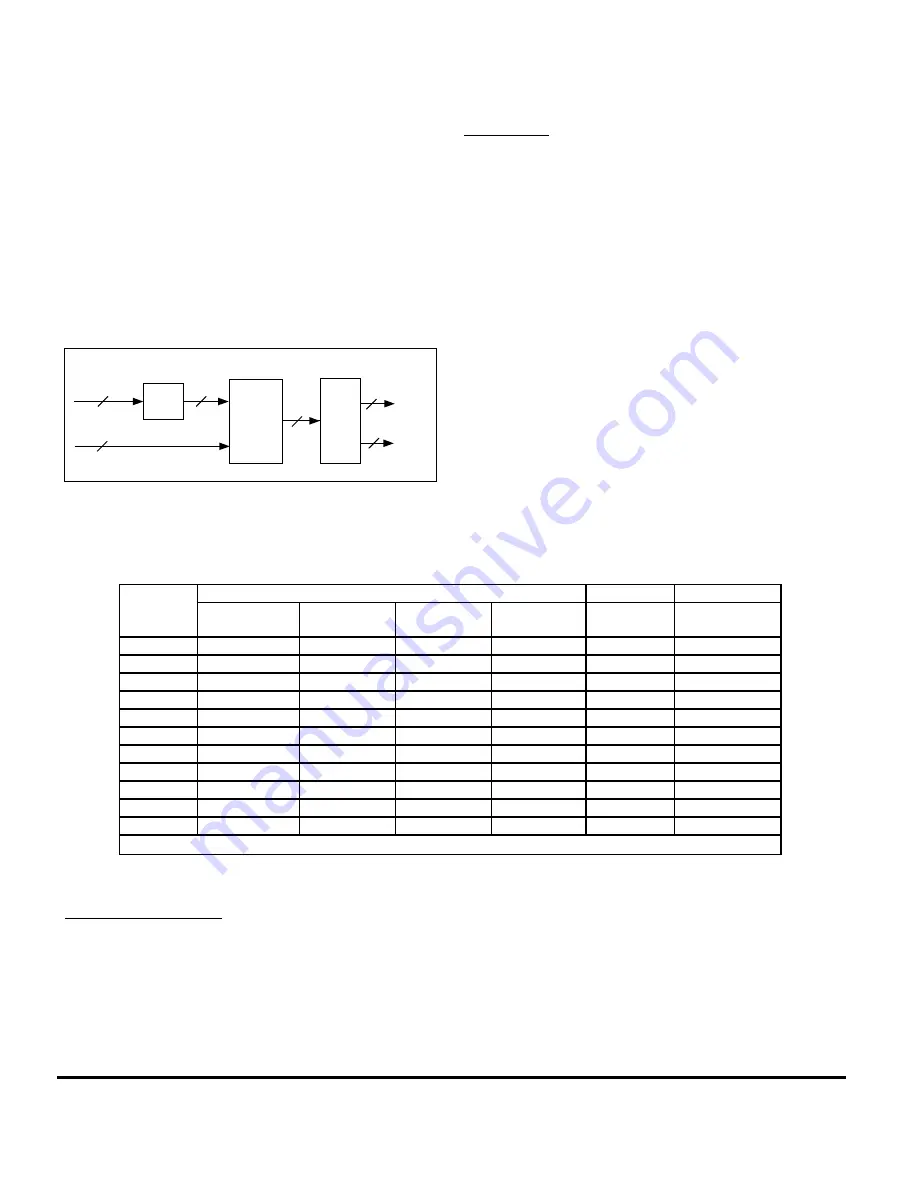
Transmitter Description
User Manual
45
STEL-2176
Symbol Mapper Block
The Symbol Mapper Block (Figure 28) maps the serial
data bits output by the Bit Encoder Block to symbols,
differentially encodes the symbols, and (in 16QAM)
maps the symbols to one of five constellations. The
Symbol Mapper Block functions are modulation
dependent. The modulation mode also defines the
number of bits per symbol. The Symbol Mapper Block
outputs 2 bits for each symbol to each of the two
Nyquist (FIR) Filters.
ENCODED
SERIAL DATA
I[1:0]
**
Q[1:0]
**
I[1:0]
*
Q[1:0]
*
I[1:0]
Q[1:0]
4
Bit
Mapper
Differential
Encoder
4
2
Symbol
Mapper
2
1
TXDIFFEN
1
WCP 53810.c-12/2/97
Figure 28. Mapping Block Functional Diagram
Bit Mapper
The Bit Mapper receives serial data and maps the serial
data bits to output symbol bits (I
1
**
, I
0
**
, Q
1
**
, and Q
0
**
).
There are four output bits per symbol even in BPSK and
QPSK modes. In BPSK, all bits are set equal to each
other. In QPSK, each input symbol bit drives a pair of
output bits. The four symbol bits are routed to the
Differential Encoder in parallel.
For BPSK modulation, each bit (symbol = b
0
) of the
input serial data stream is mapped directly to I
1
**
, Q
1
**
,
I
0
**
, and Q
0
* *
(i.e., I
1
**
= I
0
* *
= Q
1
**
= Q
0
**
= b
0
). Thus, bit
mapping has no affect on the respective value of the
symbolÕs four bits, as shown in Table 38.
For QPSK modulation, each pair of bits (a dibit) forms a
symbol (b
0
b
1 )
. The QPSK dibit is mapped so that
I
1
**Ê
=ÊI
0
**
and Q
1
**
=
Q
0
**,
as shown in Table 38.
For 16QAM, every four bits (a nibble) forms a symbol
(b
0
b
1
b
2
b
3
). The 16QAM nibble is mapped to I
1
**
, Q
1
**
, I
0
**
,
and Q
0
**
, as shown in Table 38.
Table 38. Bit Mapping Options
Bit-To-Symbol Mapping
Bit Mapping
Mod Mode
Mode
b
0
b
1
b
2
b
3
Register 2D
bits 6-4
Register 2C bits
3,2
BPSK
I
1
**
Q
1
**
I
0
**
Q
0
**
N/A
N/A
N/A
XXX
1X
QPSK
I
1
**
I
0
**
Q
1
**
Q
0
**
N/A
N/A
XX0
00
QPSK
Q
1
**
Q
0
**
I
1
**
I
0
**
N/A
N/A
XX1
00
16QAM
I
1
**
I
0
**
Q
1
**
Q
0
**
000
01
16QAM
Q
1
**
Q
0
**
I
1
**
I
0
**
001
01
16QAM
I
0
**
I
1
**
Q
0
**
Q
1
**
010
01
16QAM
Q
0
**
Q
1
**
I
0
**
I
1
**
011
01
16QAM
I
1
**
Q
1
**
I
0
**
Q
0
**
100
01
16QAM
Q
1
**
I
1
**
Q
0
**
I
0
**
101
01
16QAM
I
0
**
Q
0
**
I
1
**
Q
1
**
110
01
16QAM
Q
0
**
I
0
**
Q
1
**
I
1
**
111
01
Note: b
0
is the first serial data bit to arrive at the Bit Mapper
Differential Encoder
The Differential Encoder encodes the bits (i.e., I
1
**
, I
0
**
,
Q
1
**
, and Q
0
* *
) of each symbol received from the Bit
Mapper to determine the output bit values (i.e., I
1
*
, Q
1
*
,
I
0
*
, and Q
0
*
), which are routed to the Symbol Mapper.
The differential encoder can be either enabled or
bypassed under the control of either a register bit or a
user supplied control signal (TXDIFFEN). The selection
between user input pin control or register control is
made in another register bit, as shown in Table 39.






























